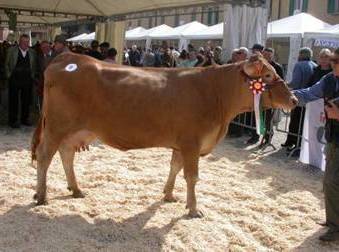Breed of the Month Archive
Reggiana breed

|
| Herd-Book creation : | 1986 |
| Number of breeding females (2007): | 1500 |
| Trend : | increasing |
| Location : | 95% of herds located in the Reggio Emilia province, Northern Italy |
|
Breed description
Females adult: 140-145 cm height (breed standard); average b.w. 650-700 kg.; red coat.
Males adult: 145-155 cm height (breed standard); average b.w. 900-1000 kg.; red coat.
Average milk production is 5,600 kg (3.4 % protein; 3.5% fat). Milk from Reggiana cows is
particularly well-suited for cheese production, because of its high percentage of casein and
properties for rennet coagulation Functional traits including fertility, longevity and hardiness
are higher with respect to the mainstream breed (Holstein Italian), whereas udder conformation
and milkability is lower.
History
Reggiana cattle was first reported to be farmed in the areas of Parma and
Reggio Emilia by monks around year 1000. The breed was the most important
cattle in these areas in 1809, and was presented at the Vienna Expo in 1873.
Pedigree registration started in the fifties and breed standards were published
in 1953. In 1986 the national Herd-book was created.
Trend of population
In the last century, population size increased to 41,000 cows around 1950. From
early fifties the substitution process with Brown Alpine and Holstein cattle started;
in 1970 population dropped to 8,000 cows and in 1981 reached the minimum of 450 cows.
From late '80, linked to conservation activities including the production of a specific
parmigiano reggiano cheese made with Reggiana milk, we observe a positive demographic trend
(Figure 1).

Figure 1. Evolution of the breed
Breeding, conservation and promotion
In 1991 a group of passionate breeders created a consortium (CVPAR: Consorzio Valorizzazione
Prodotti Antica Razza Reggiana) to add value to the breed by producing a Parmigiano Reggiano c
heese made with Reggiana milk, labeled "Parmigiano Reggiano delle Vacche Rosse" (Figure 2). Since
its appearance on the market, this branded Reggiana Parmigiano Reggiano encountered good acceptance
by consumers that were ready to pay progressively from 30 to almost 100% more with respect to generic
Parmigiano Reggiano cheese. Following this renewed interest for the breed, the number of Reggiana
cows is progressively increasing. Other conservation activities include the creation of a cryobank
and index selection with control of inbreeding.
|

Figure 2: Parmigiano Reggiano delle Vacche Rosse
|
Contact
Breeders Association: Associazione Nazionale Allevatori Bovini di Razza Reggiana (ANABoRaRe)
Dr. Villa, Tel. and Fax +39 0522 271396,
naborare@razzareggiana.it





